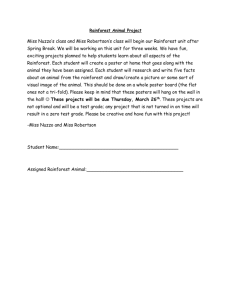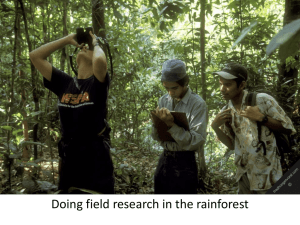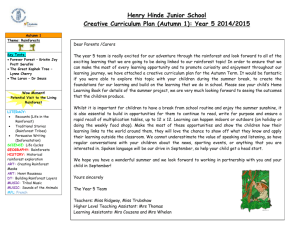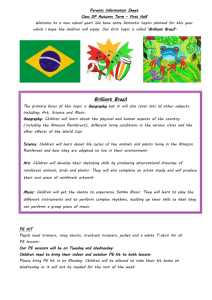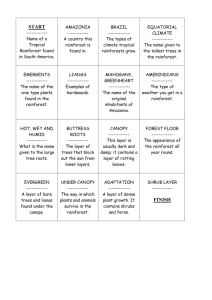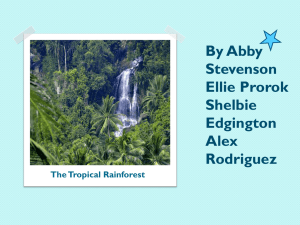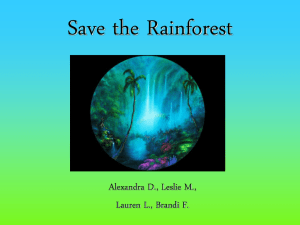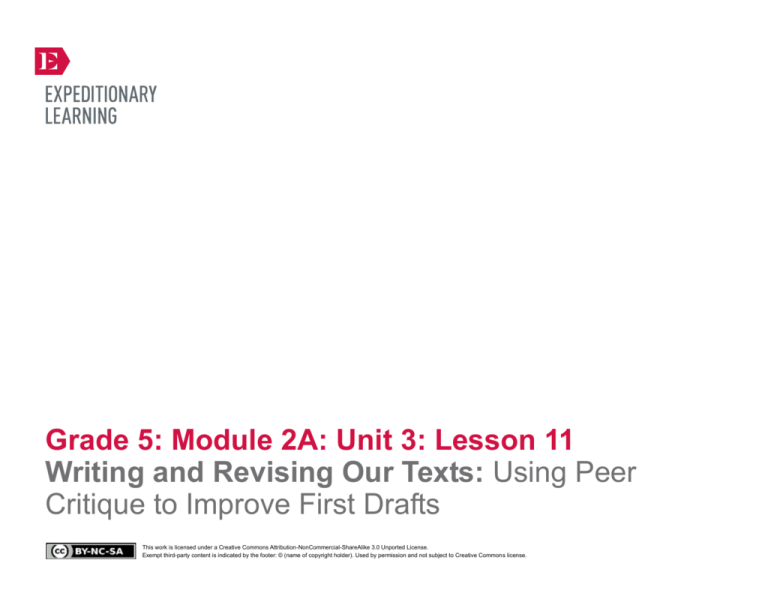
Grade 5: Module 2A: Unit 3: Lesson 11
Writing and Revising Our Texts: Using Peer
Critique to Improve First Drafts
This work is licensed under a Creative Commons Attribution-NonCommercial-ShareAlike 3.0 Unported License.
Exempt third-party content is indicated by the footer: © (name of copyright holder). Used by permission and not subject to Creative Commons license.
GRADE 5: MODULE 2A: UNIT 3: LESSON 11
Writing and Revising Our Texts:
Using Peer Critique to Improve First Drafts
Long-Term Targets Addressed (Based on NYSP12 ELA CCLS)
I can write informative/explanatory texts that convey ideas and information clearly. (W.5.2)
I can write narrative texts about real or imagined experiences or events. (W.5.3)
I can choose evidence from fifth-grade informational texts to support analysis, reflection, and research. (W.5.9)
I can write for a variety of reasons. (W.5.10)
Supporting Learning Targets
Ongoing Assessment
I can organize the events I describe in my rainforest journal entry in chronological order.
Rainforest Field Journal Entry graphic organizer
I can use linking words and phrases to connect my ideas.
Postcards
I can include precise and scientific vocabulary in my rainforest journal entry.
Copyright © 2013 by Expeditionary Learning, New York, NY. All Rights Reserved.
NYS Common Core ELA Curriculum • G5:M2A:U3:L11 • June 2014 •
1
GRADE 5: MODULE 2A: UNIT 3: LESSON 11
Writing and Revising Our Texts:
Using Peer Critique to Improve First Drafts
Agenda
Teaching Notes
1. Opening
This lesson involves students writing postcards from the perspective of their rainforest explorer. This
gives students a simple and fun way to practice sequencing their writing clearly and providing specific
details. Note that in this era of email, Facebook, and Skype, you may have to show models to your
students and explain to them what a postcard is. It will be helpful to have a collection of real picture
postcards available to share with your students (photos of any subject are fine; need not be of the
rainforest).
B. Writing Practice: Postcards from the Perspective of
Our Rainforest Scientist(15 minutes)
If you have none available, consider using Google Images to project images of postcards, or see
suggestions in supporting materials.
C. Independent Work Time (20 minutes)
If technology permits, consider having students create an e-postcard during another time of the day.
In advance: Complete the 2 and 1 columns of the Ideas row of the Rainforest Field Journal Rubric (see
model in supporting materials).
Review Glass, Bugs, Mud strategy (see Appendix).
A. Unpacking the Learning Targets (10 minutes)
2. Work Time
A. Creating Our Rubric: Organization and Language (10
minutes)
3. Closing and Assessment
A. Debrief and Exit Ticket (5 minutes)
4. Homework
Lesson Vocabulary
Materials
organize, sequence, chronological,
rubric, postcard, recipient
Rainforest Field Journal Entry graphic organizer (from Lesson 10)
Rainforest Field Journal Entry rubric (one to display)
Sample Rainforest Field Journal rubric (for Teacher Reference)
The Most Beautiful Roof in the World, by Kathryn Lasky (one to display)
Collection of sample picture postcards (of any subject)
4”x6” unlined index cards (one per student)
Copyright © 2013 by Expeditionary Learning, New York, NY. All Rights Reserved.
NYS Common Core ELA Curriculum • G5:M2A:U3:L11 • June 2014 •
2
GRADE 5: MODULE 2A: UNIT 3: LESSON 11
Writing and Revising Our Texts:
Using Peer Critique to Improve First Drafts
Opening
Meeting Students’ Needs
A. Unpacking the Learning Targets (10 minutes)
Gather the students. Make sure they all have their Lesson 10 homework: Rainforest Field Journal Entry graphic
organizer. Cold call one or two students who haven’t yet shared to tell the class about the ideas in their graphic organizer.
Read the first two learning targets aloud: “I can organize the events I describe in my rainforest journal entry in
chronological order,” and “I can use linking words and phrases to connect my ideas.” Tell students that today they will be
working on organizing and sequencing their writing.
Write these three sentences on the board:
Consider giving ELLs an
additional support mini-lesson on
vocabulary related to linking
words and phrases.
* “I washed out the bowl and put it away.”
* “I ate a bowl of cereal.”
* “I poured some cereal into a bowl.”
Ask students to do the following:
1. Rearrange the sentences in the correct order.
2. Find ways to link the sentences.
Listen for answers such as “next,” “then,” and “finally.” Encourage phrases as well as single-word responses, such as
“Shortly after waking up,” and “When I finished eating.” Explain that when events are recounted in the order they occurred
they are in chronological order. Journal entries are generally in chronological order. Point out that the word chronological
is made up of the root chrono-, which has to do with time (like synchronize), and the word -logical, which they will
probably recognize and be able to define as making sense or orderly. Tell the students that today they will be working to
make sure their journal entries are well organized, so that they meet these learning targets.
Read the third learning target aloud: “I can include precise and scientific vocabulary in my rainforest journal entry.”
Remind the students of all of the vocabulary that they have collected in the glossaries in their journals. Tell them that these
words are going to be very useful to them in their writing because their rich vocabulary will enable them to write clearly
and precisely, like a scientist.
Copyright © 2013 by Expeditionary Learning, New York, NY. All Rights Reserved.
NYS Common Core ELA Curriculum • G5:M2A:U3:L11 • June 2014 •
3
GRADE 5: MODULE 2A: UNIT 3: LESSON 11
Writing and Revising Our Texts:
Using Peer Critique to Improve First Drafts
Work Time
Meeting Students’ Needs
A. Creating Our Rubric: Organization and Language (10 minutes)
Remind students that they have already done their research and made outlines. Project the Rainforest Field Journal
Entry rubric (begun during Lesson 10). Direct the students’ attention to the IDEAS section and point out the “2—I’m on
my way” and “1—I’m getting started” columns that you have completed. Assign pairs of students to read just one row
across (one criterion) and talk with each other:
* “What are the differences between a 1, 2, and 3?”
Cold call pairs to share what they discussed.
Tell students that now that they have completed the IDEAS section of the rubric, they will focus on the Organization and
Language sections. This will help them today as they turn their outlines into drafts.
Scroll down to the ORGANIZATION section of the rubric. Ask the students: “What will you need to do to meet the target of
writing a well-organized rainforest field journal entry?” Listen for and record two criteria that capture these concepts:
Visuals can help ELLs and other
students comprehend questions
and discussions. Chart main
points in answers and post all
questions asked to students about
the rubric.
* The events in my field journal entry are organized in chronological order, and
* I have connected the events by using linking words and phrases.
Next, scroll down to the LANGUAGE section. Say: “Remember when we were reading The Most Beautiful Roof in the
World we talked about the kind of language that the author used to paint a vivid picture of the rainforest? For example, on
page 10, the author writes that ‘bats swoop,’ ‘vipers coil,’ and ‘a salamander slinks.’ How would it change the effect on the
reader if the author had written that, ‘bats fly,’ ‘vipers live,’ and ‘a salamander crawls’?” Lead the students to an
understanding that these verbs have a precision that creates a particularly clear and vivid image of the way the animals
move.
Remind the students of the work they did in their own field journals to try to capture the world around them using precise
language and sensory details. Now ask students for suggestions of what criteria belong in the Language section of the
rubric. Listen for and record three criteria that capture these concepts:
* I have used scientific vocabulary (at least five words).
* I have written precise descriptions (at least three descriptions).
* I have written sensory details (at least three details).
Copyright © 2013 by Expeditionary Learning, New York, NY. All Rights Reserved.
NYS Common Core ELA Curriculum • G5:M2A:U3:L11 • June 2014 •
4
GRADE 5: MODULE 2A: UNIT 3: LESSON 11
Writing and Revising Our Texts:
Using Peer Critique to Improve First Drafts
Work Time (continued)
Meeting Students’ Needs
B. Writing Practice: Postcards from the Perspective of Our Rainforest Scientist (15 minutes)
Tell students that they are going to practice sequencing events clearly and using precise language by writing a postcard from the
perspective of their rainforest scientist.
This is an opportunity to
provide additional
support to ELLs or other
students who need extra
time and attention to
complete the task.
Students who struggle
with language may
benefit from a sentence
stem or cloze sentence to
use for suggestions of
sentences for the
postcard (e.g., “I am in
the __________
rainforest and I see
____________.”).
Ask the students: “What is a postcard? Why do people send postcards?” If possible, display a collection of sample picture
postcards. Talk with them about characteristics of postcards (demonstrate if you have models):
* One side typically has a photograph of the place where they are sent from
* The other side has a short message
* The messages usually tell one small piece of information, and also usually let the recipient know how the sender is doing.
Ask the students: “What do you think Meg Lowman would write on a postcard to James and Edward if they weren’t with her?”
Create a model postcard by drawing a large rectangle on the white board with a line down the middle to denote the address area, and
a place for a stamp in the top right corner. Choose one student to contribute the first line of the postcard, which will be the date, and
“Dear James and Edward.” Write this on the model postcard or select a student to do the writing.
In round-robin fashion, have several students contribute one sentence to the postcard. If necessary, prompt students to include a
detail or two that Meg Lowman might include in the postcard, such as having seen a Gabon viper in her tent (page 35), or having
discovered a new kind of spider (page 37). As in a typical postcard, they should also include a personal message, such as “I miss you,”
or “See you soon!” and a closing.
Explain that they will be writing postcards from the rainforest explorer they have created. Distribute unlined 4”x6” index cards to
each student. Ask them to take out their Rainforest Field Journal graphic organizers and review their notes about the events that
they are going to be writing about.
Ask students to pretend that their character is writing the postcard near the beginning of their trip, so it should include something
about the first event that they have listed. Ask students to decide:
* “Who will be the recipient of your postcard?”
Clarify this vocabulary as needed: The recipient is the person receiving the postcard (i.e., the explorer’s friend, child, spouse, etc.).
Ask students to address their postcard to that person.
Tell students that this writing will not be formally graded: It is just a chance for them to practice organizing their ideas and writing
with specific details from their research.
Copyright © 2013 by Expeditionary Learning, New York, NY. All Rights Reserved.
NYS Common Core ELA Curriculum • G5:M2A:U3:L11 • June 2014 •
5
GRADE 5: MODULE 2A: UNIT 3: LESSON 11
Writing and Revising Our Texts:
Using Peer Critique to Improve First Drafts
Meeting Students’ Needs
Work Time (continued)
Give students 10 minutes of quiet work time to write their postcards.
As students work, fill in the Organization and Language rows of the rubric (see supporting materials for model).
Circulate to scan students’ postcard writing. Look for a few strong examples to share as models during the lesson debrief.
C. Independent Work Time (20 minutes)
Make sure that the rubric the class has created remains prominently displayed.
Instruct students to turn to a new page in their journals.
Tell the class that they will now start writing the first drafts of their field journal entries. Encourage the students to “put on
their rainforest explorer hats” and pretend that they are really in the rainforest as they start to write their journal entries.
Remind the students that all field journal entries start with a date, so they should decide when their rainforest exploration
has taken place and note that at the top of the page. Then they should describe the first events listed in their graphic
organizer. These will be the same events they wrote about on their postcard, but now they can add more details,
descriptions, and precise and scientific vocabulary.
Give students 20 minutes of quiet work time to start their rough drafts. While most students are working quietly and
independently, this is an opportunity to work with a small group of students who need more support. Consider working
with students who weren’t able to complete the graphic organizer independently or those who self-assessed themselves low
during the previous lesson’s Fist to Five debrief.
Options for additional support:
Consider allowing students who
struggle with writing to dictate the
sentences for the postcards to a
partner or the teacher.
* Give students sentence starters or a scaffolded writing template.
* Do a think-aloud with the students in your small group, turning the notes that you created during the previous day’s mini
lesson into a field journal entry. For your think-aloud, use a blank piece of paper or chart paper, write a date, then skip a
line and begin thinking aloud, saying something like: “Today we set out for a section of the river that we had not yet
explored. The students seem a little tired. I know they are sick of eating beans and rice every day, and miss the food back
home.” Continue for a bit in this vein, incorporating all of the information on your graphic organizer.
* Show students how to use a highlighter to mark the information as you use it to keep track of what you’ve incorporated.
Copyright © 2013 by Expeditionary Learning, New York, NY. All Rights Reserved.
NYS Common Core ELA Curriculum • G5:M2A:U3:L11 • June 2014 •
6
GRADE 5: MODULE 2A: UNIT 3: LESSON 11
Writing and Revising Our Texts:
Using Peer Critique to Improve First Drafts
Meeting Students’ Needs
Closing and Assessment
A. Debrief and Exit Ticket (5 minutes)
Have students mingle and share postcards with classmates. After a few minutes, pull the class together and ask students to
name a classmate whose postcard they think should be shared with the class because it has a really cool specific detail.
Have a few nominated students read their postcards aloud.
Collect the postcards at the end of the lesson to use as a formative assessment to see whether the students are able to create
a character and summarize a plot point from their graphic organizer.
Review the three learning targets for the lesson: “I can organize the events I describe in my rainforest journal entry in
chronological order,” “I can use linking words and phrases to connect my ideas,” and “I can include precise and scientific
vocabulary in my rainforest journal entry.” Use the Glass, Bugs, Mud strategy to assess where students are in terms of their
mastery of the targets.
Meeting Students’ Needs
Homework
Read the section of your field journal that you have completed to someone at home. Ask that person to tell you what else
they would like to know about your explorer’s adventure in the rainforest. Write down their questions.
Copyright © 2013 by Expeditionary Learning, New York, NY. All Rights Reserved.
NYS Common Core ELA Curriculum • G5:M2A:U3:L11 • June 2014 •
7
Grade 5: Module 2A: Unit 3: Lesson 11
Supporting Materials
This work is licensed under a Creative Commons Attribution-NonCommercial-ShareAlike 3.0 Unported License.
Exempt third-party content is indicated by the footer: © (name of copyright holder). Used by permission and not subject to Creative Commons license.
GRADE 5: MODULE 2A: UNIT 3: LESSON 11
Rainforest Field Journal Rubric
I can write a field journal entry from the point of view of a rainforest scientist.
I can use my notes to write a field journal entry that includes details about ants or butterflies.
3
I met the target!
2
I’m on my way.
1
I’m getting started.
Ideas
Organization
Language
Conventions
Copyright © 2013 by Expeditionary Learning, New York, NY. All Rights Reserved.
NYS Common Core ELA Curriculum • G5:M2A:U3:L11 • June 2014 •
9
GRADE 5: MODULE 2A: UNIT 3: LESSON 11
Rainforest Field Journal Rubric
(For Teacher Reference – to be co-created by teacher and students)
)
I can write a field journal entry from the point of view of a rainforest scientist.
I can use my notes to write a field journal entry that includes details about ants or butterflies.
Ideas
3
I met the target!
• I have included careful
observations of the
rainforest environment.
• I have included personal
information about who I
am and what I am
thinking and doing.
• I have included accurate
scientific information
about rainforest ants or
butterflies.
Organization • The events in my field
journal entry are
organized in
chronological order.
• I have connected the
events by using linking
words and phrases.
Copyright © 2013 by Expeditionary Learning, New York, NY. All Rights Reserved.
2
1
I’m on my way.
I’m getting started.
• I have not included much • I have not included any
detail in my observations
observations of the
of the rainforest
rainforest environment.
environment.
• I have not included any
• I have included some
personal information
personal information
about who I am and what
about who I am and what
I am thinking and doing.
I am thinking and doing. • I have not included any
• I have included some
accurate scientific
information about
rainforest ants or
butterflies.
accurate scientific
information about
rainforest ants or
butterflies.
• The events in my field
journal entry are not
totally organized in
chronological order.
• The events in my field
journal entry aren’t
organized in
chronological order.
• I have connected some of
the events by using
linking words and
phrases.
• I haven’t connected the
events by using linking
words and phrases.
NYS Common Core ELA Curriculum • G5:M2A:U3:L11 • June 2014 •
10
GRADE 5: MODULE 2A: UNIT 3: LESSON 11
Rainforest Field Journal Rubric
(For Teacher Reference – to be co-created by teacher and students)
I can write a field journal entry from the point of view of a rainforest scientist.
I can use my notes to write a field journal entry that includes details about ants or butterflies.
Language
3
I met the target!
• I have used scientific
vocabulary (at least five
words).
2
I’m on my way.
• I have used scientific
vocabulary (at least three
words).
1
I’m getting started.
• I have used one or no
scientific vocabulary
words.
• I have written precise
descriptions (at least
three descriptions).
• I have written precise
descriptions (at least two
descriptions).
• I have written one or no
precise descriptions.
• I have written sensory
details (at least three
details).
• I have written sensory
details (at least two
details).
Conventions • I can use periods,
question marks,
exclamation points,
quotation marks, and
commas correctly.
• I can capitalize proper
nouns and the first letter
of sentences.
• I can spell all of the
words in my field journal
correctly, including the
scientific words from my
glossary.
Copyright © 2013 by Expeditionary Learning, New York, NY. All Rights Reserved.
• I have written one or no
sensory details.
• I can use periods,
• I did not use periods,
question marks,
question marks,
exclamation points,
exclamation points,
quotation marks, and
quotation marks, and
commas correctly most of
commas correctly.
the time.
• I did not capitalize
• I can capitalize proper
proper nouns and the
nouns and the first letter
first letter of sentences.
of sentences most of the
• I did not spell all of the
time.
words in my field journal
• I can spell most of the
words in my field journal
correctly, including the
scientific words from my
glossary.
correctly.
NYS Common Core ELA Curriculum • G5:M2A:U3:L11 • June 2014 •
11

